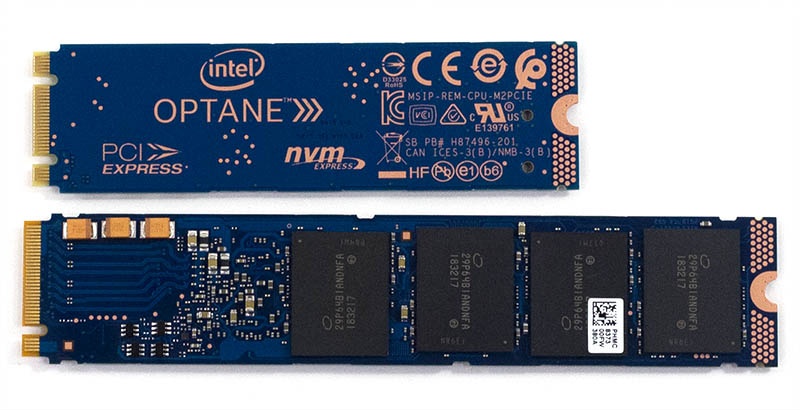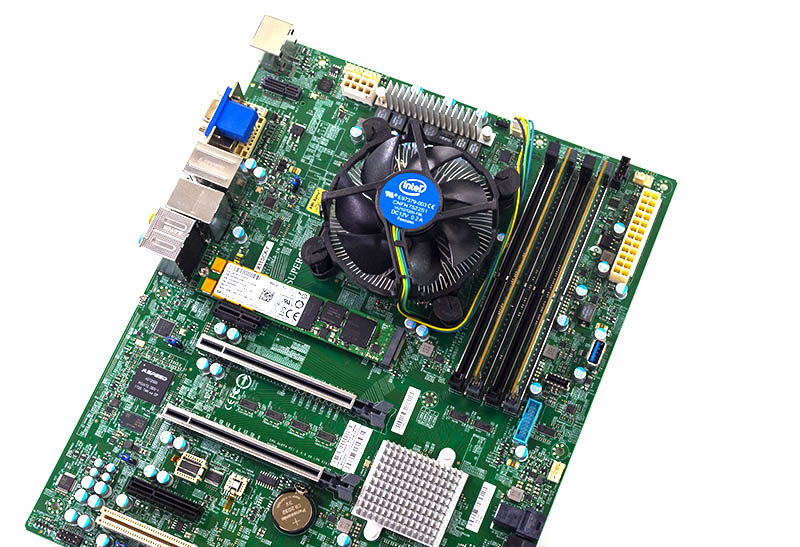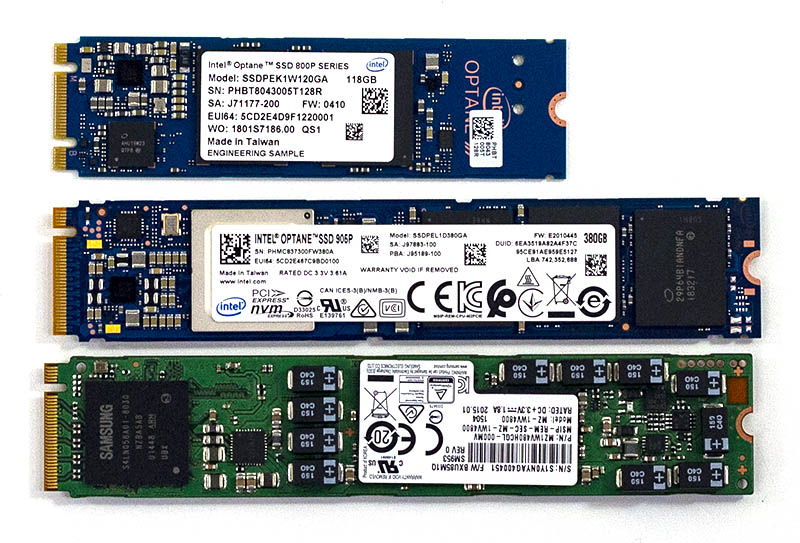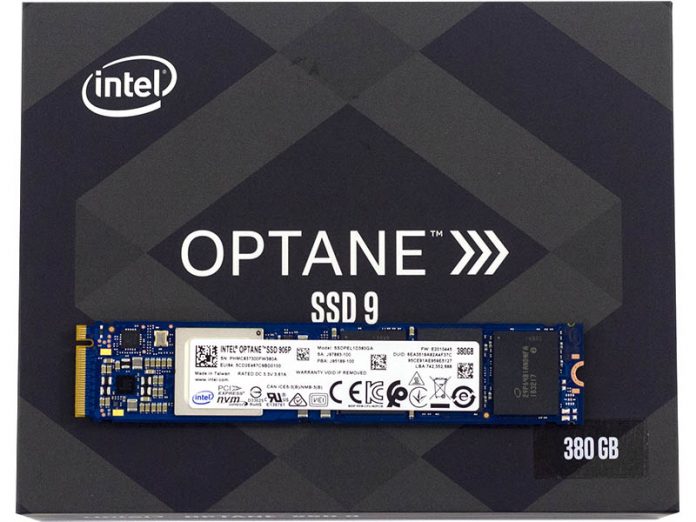At Computex 2018, one of the products that we saw that I personally was most excited for was the Intel Optane 905P 380GB M.2 drive. This small NVMe device is an absolute game-changer for servers. Realistically, on the desktop, most will be better off using AIC or U.2 devices, cabling for the U.2 devices. Intel even has a kit to wire a U.2 drive to a M.2 slot which is great for desktops. You can see the difference between Intel Optane 900p 280GB SSDPE21D280GASM and SSDPE21D280GASX we highlighted when the drives first came out. In servers, the Intel Optane 380GB M.2 device is the highest endurance (~7PBW) option currently available in a M.2 22110 drive. It is also the fastest M.2 logging device for sync writes that occur in server applications. Today that wait is over and we have a retail purchased Intel Optane 905P 380GB NVMe SSD. If you run a ZFS storage array and need a ZIL/ SLOG device in an M.2 slot, this is it. If you have small databases in the few hundred MB to few GB range that need solid write performance, this is the drive you want.
Intel Optane 905P 380GB M.2 Drive Overview
The Intel Optane 905P M.2 drive is a relatively simple device. Here is what the top of the device looks like:

Here is the bottom of the Intel Optane 905P. You can notice the lack of DRAM cache onboard.

We wanted to take a second and mention, Intel Optane 800P drives come in capacities of up to 118GB. At 380GB, the Intel Optane 905P is the first really usable capacity M.2 Optane drive for primary storage applications. It is also a full PCIe 3.0 x4 enabled NVMe SSD, unlike some of the earlier PCIe x2 NVMe Optane drives put into the market. One of the key differences between the M.2 NVMe Optane drives we have seen thus far and the Intel Optane 905P 380GB M.2 is that the newer drive has backside 3D XPoint packages. That, along with over 9W of power consumption when active, raises the cooling needed for these devices.

Diverging from the desktop norm, the Intel Optane 905P 380GB is a M.2 22110 drive size which means it is 110mm long. That is important. Many motherboards, especially embedded mITX motherboards, only have M.2 2280 or 80mm long slots. Even many of the lower-cost PCIe slot to M.2 adapters only support 80mm drives. You need to be careful when spec’ing your server for the size drives it supports. You also need PCIe enabled M.2 slots as we have seen quite a few server and embedded motherboards with only SATA wired M.2 slots. Compatibility is a factor, however, most higher-end server hardware will support 110mm drives. The 110mm form factor is essentially what you need for a NAND M.2 drive to also have PLP circuitry. In the lab, we have had to use drives from SK.Hynix and Samsung. The PLP enabled M.2 drives we have tested, such as the one we use in our Supermicro X11SCA-F Review, are frankly slow.

2GB/s read/ write are often more than these drives can handle, and many top out at well under 1.5GB/s. The pictured SK.Hynix PE3110 runs around 1.7GB/s read and 750MB/s write and falls off considerably under heavy sustained workloads (it is generally fine on 90/10 or 70/30 workloads.) Other popular options we have in the lab include the Samsung PM953 M.2 22110 drive that is slightly faster at 850MB/s writes but only 1GB/s reads. A Seagate XP400HE30002 will hit just under 2GB/s read and 1.2GB/s writes.

The common theme has been 110mm M.2 drives with PLP capacitors tend to sacrifice performance considerably to fit into these cases. For large hyper-scale clients where they are designed to be used in JBOFs like the OCP Lightning that we also saw on our visit to Wiwynn recently, where PCIe switches are used and thus a single drive is not expected to fill a PCIe 3.0 x4 path’s bandwidth.
As you are going to see, the Intel Optane 905P 380GB M.2 NVMe SSD is able to read and write at over 2GB/s.
Next, we are going to talk about the Intel Optane 905P power loss protection, a question we get frequently. We then discuss specs and measured power consumption before moving onto performance and our final thoughts.




That’s a lot to digest but some great data.
So if you’re constrained to 110mm
And 380GB is enough capacity
And you need high endurance or fast response times
And you can swing $500
And the power and cooling are OK for your machine
Then it’s a good drive.
I get it. It’s a niche product. I’m still just ordered 2
Hot drive. This review is spot on. It’s a $#$$@! to find a fast 22110 M.2
380GB is enough capacity
And you can swing $500
LOL,
better if they sell it for $400 or less.
Does this give the same kind of uber-high performance when used as a drive for MS-SQL log files? I could also see it potentially being awesome as a MS-SQL tempdb drive
4 of those in a $60 ASUS Hyper M.2 x16 x Interface Card PCI Express 3.0 in raid 10 and you have a great fast ZIL device.
I assume these drives perform just as well if they are in AMD servers? I’ve not seen much information about doing this type of setup.
Troy – that would be a great use case
Misha Engel – Perhaps. There is actually a lot of overhead pushing that much NVMe small I/O performance quickly plus RAID 10. Usually, 1 or 2 (mirror) is good enough for most ZIL / SLOG configurations
Jared Geiger – We tested in Threadripper and EPYC. So long as you are on the same NUMA node, you get the performance you would expect. NUMA node to NUMA node, you see a bit of extra latency.
That’s sexy AF
@Patrick Kennedy: 40Gbs ethernet needs a lot of speed and we need some buffer for the 1+ PB of spinning drives, lucky for us FreeBSD 12.0 is out now with good support for EPYC so we can start to build our multiple ZFS RaidZ3+1hotspare in a 16+3+1 config with EPYC7551P. We need it for large seq. R/W. (video editing and storage).
@Misha Enge I love it when I see ppl save $$ thru AMD CPUs and give it back 2 Intel thru a memory product.
@Vlad: As long as it works the way I want, I don’t care where the hardware/software comes from.
By the way, roadmaps show a 760GB M.2 905P coming for those that need greater capacities.
How does it performance compares with 905P 480GB U.2 drive?
Igor – pretty close to the point that the form factor is going to be the reason you go M.2. Also, in the server world, a ~10W part as big as an M.2 drive is trivial to cool. In workstations, you will likely want a heatsink as there is a lot less surface area on the M.2 drive than the U.2 drive.
For things like FS journal / ZIL or database logs (WAL, doublewrite / undo log etc.), a device like this might be even more interesting: https://www.microsemi.com/product-directory/storage-boards/3690-flashtec-nvram-drives (sadly no M.2), or using NVDIMM, but I haven’t seen either in the wild, they seem to be hard to procure.
I think a separate fsync() benchmark would be very interesting, I’d wager the NAND based devices perform a lot worse here, unless they have capacitor protection for the DRAM or simply lie about durable writes:
https://www.percona.com/blog/2018/07/18/why-consumer-ssd-reviews-are-useless-for-database-performance-use-case/
Especially for small databases write+fsync performance may be all you (need to) care about.
Optane is simply superiour regarding performance
What I currently miss are the typical SAS advantages “hot removable/replaceable”, “Dualpath” for HA setups and scaleable to hundreds of disks. Sadly there is no 12G Dualpath SAS disk based on Optane technology. This would be the real storage break-through.
The U.2 drives are better in many ways than the M.2 form factor. NVMeoF applications will take over. Once you can put NVMe on 25GbE the ability to provide HA clustered storage goes up tremendously. The cloud providers are dictating the next directions in storage.
I put one of these in an ASUS Gene XI motherboard in the DIMM.2 riser card paired with a 970 Pro 1TB for sequential read/writes. I’ve test VM startup times, database backup times, game loading, unraring and copying the Windows folder. The 970 Pro only won in the unraring test, all other test were won by the 905P. Those tests plus the fact that endurance is crazy means I’m very happy with the purchase.
Patrick Great Review Congrats !!!
I currently use an Optane SSD 900P 280GB and a 4x2TB NVMe Storage on ASRock ULTRA QUAD M.2, I would like to upgrade my SSD 900P to 480GB but just saw this, and the SSD 905P seems faster. Can’t decide which one to go, if the 905P 380GB M.2 110 or the 905P 480GB U.2, this one is a bit cheaper and 100GB more…is there any differences in perforamance between them ?
Thanks a lot, all the best, Sergio!
Geez, what ever happened to the old days when we could buy an AST Ramdisk expansion board, stuff it with DRAM and have a REAL Ramdisk!? The things I’d do to get a PCIe 4.0 version of that old board. Even a a PCIe 3.0 would be acceptable. Any such animals still around?